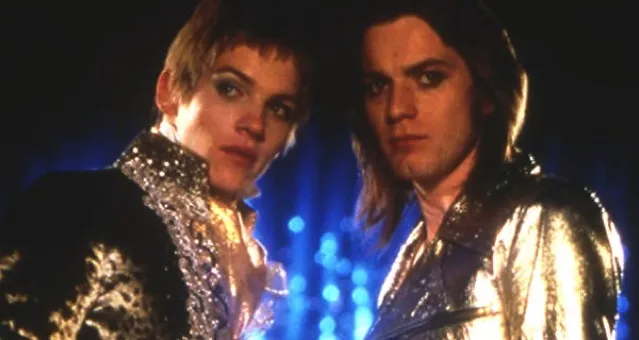
Shippers, Recs and OTPs: A History of Fan Fiction
This content contains affiliate links. When you buy through these links, we may earn an affiliate commission.
What does fan fiction mean to you? Fandom—in my head, I’ve always thought of the word as a fan kingdom, like our own obsessive mini-worlds—is a labour of love. It’s a critical way of devouring beloved characters, examining what could—should—be different. As a teen, I got into fanfic partially because I was bored of constantly being told by media that only men and women could feel chemistry together. I knew it wasn’t true, because I felt all sorts of feelings for other women, and fan fiction was a way for me to write that wrong (get it?).
Even before fan fiction expanded into the queerfest it can be, it was still about fixing or expanding on aspects of a fandom that felt lacking. In Here We Are: Feminism For the Real World, Brenna Clarke Gray points out the choosing your own path aspect to fandom: “…take those characters you love and reinvent their situations, bend their race and gender, and experiment with their sexuality.” Basically, take those characters and play.
Fan fiction has more recently gone mainstream, with articles popping up in The New Yorker and The Guardian. No longer are these stories being furtively written (or read) under cloaks of late night secrecy. Fan fiction writers have published books based on the borrowed characters (names changed, naturally), or their own original fiction. It’s used as a plot device in YA novels such as Rainbow Rowell’s Fangirl and Chris Colfer’s Stranger than Fanfiction. It has become so blasé to be known for writing fanfic, in fact, that published authors such as S.E. Hinton and Neil Gaiman even admit to it—writing Supernatural and Chronicles of Narnia fics, respectively.

The Early Days
The OG fan fiction fandom is widely known to be Star Trek, but the history goes further back than that. As Lev Grossman writes in fic: Why Fanfiction is Taking Over the World, Jean Rhys’s Wide Sargasso Sea comes from Charlotte Brontë’s Jane Eyre, while Tom Stoppard’s Rosencrantz and Guildenstern Are Dead tells the stories of two side characters from Shakespeare’s Hamlet. Sherlock Holmes has continued to be popular in fan fiction, with authors from J.M. Barrie to Anthony Horowitz dreaming up adventures for the famous detective.Why Do So Many People Love Fanfic?
It can be a wonderful tool for burgeoning authors, giving them a safe space to hone their skills and providing keen readers to offer feedback, free editing, and collaboration. The characters are already built, so it’s easier to focus on aspects like plot and style. Also, the community is mostly women, and usually very gay-positive. When I had no out gay friends in real life, I knew some through fandoms (I got very into Velvet Goldmine fanfic at the end of high school. Brian/Curt 4 Life!)
Basic Terms
Angst, AU/alternate universe, Fluff, Smut, Sillyfic, Darkfic. See this for more.Terms Requiring More Explanation
- Beta Readers are the kind, beautiful humans who read your story first and offer free editing. Free editing? That never happens outside of the fanfic community!
- Hurt/Comfort explores concepts of vulnerability and friendship.
- Slash refers to the “/” between names of a pairing (e.g. Harry/Draco). It’s used only in reference to same-sex romance, though.
An Intro to Important Fandoms
Star Trek
“To Boldly Go Where No Man Has Gone Before…” is the tagline that launched a thousand slash ships. According to fic, Star Trek fanfic began in ‘zines. Fans found the dynamic between Kirk and Spock engaging and, since no female characters were shown as equals to either of the show’s leading men, the best way to explore romance with either character was to pair them together. Slowly, these stories became known within the fandom itself, and creator Gene Roddenberry acknowledged the slash pairing’s existence in 1979. In 1975, Jacqueline Lichtenberg, Sondra Marshak, and Joan Winston co-wrote Star Trek Lives!, a book which examined the fan culture of the show. It had a whole chapter about fanfic, and was a legitimate reference source with a forward by Roddenberry.The X-Files
This show was deliciously quirky, terrifyingly dark, and as an added bonus it played with gender roles. Fans were either desperate for Fox Mulder and Dana Scully to get together (‘shippers) or they staunchly wanted them kept apart. The show treated Mulder and Scully as equals (mostly), still rare at that time in pop culture.Buffy the Vampire Slayer
Noteworthy for the fact that Whedon and the rest of the show writers regularly perused their show’s official message board, The Bronze. Along with defending their writerly decisions, the show creators could tease future plots and take in information about what fans were clamouring for.Harry Potter
Where do you start with this one? Fans are passionate about Harry Potter—there are theme parks, movies, movie prequels, themed balls, costumes, wands, books about the books, bands that play “wizard rock”, socks, T-shirts and many websites. You could definitely devote an entire book to the history of HP fandom, with its various dramas, pairings and breakout stars. The devotion of its fanbase led to the creation of sites like MuggleNet and FictionAlley, and some writers became successful YA novelists (Cassandra Clare and Sarah Rees Brennan). J.K. Rowling’s world was perfect for fanfic, packed with more characters than it had time to properly develop (Draco Malfoy! Remus Lupin! etc). Harry/Draco is one of the most popular slash pairings in fandom, and Tom Felton, who played Draco in the films, recently admitted to being a Harry/Draco fan.Twilight and Fifty Shades of Grey
Twilight’s sparkly, sexy vampire romance lead to E L James’s love-it-or-hate-it novel Fifty Shades of Grey. Originally posted to Fanfiction.net in 2009, then-named Master of the Universe was popular as a Twilight fic. It wasn’t long after that James renamed the characters and removed the most obvious references before publishing the novel, which took off in a big way. James’s backstory as a fanfic writer was a big catalyst to fanfic’s mainstream introduction. Do authors get angry about it? Yes, some. Anne Rice and Diana Gabaldon? They are not into it. Some creators argue that it’s illegal and can compromise their rights. This backlash has led to the 2007 creation of The Organization for Transformative Works (OTW), a nonprofit organization by and for fanfic writers. Their work includes projects like Archive of Our Own (AO3) and providing legal advocacy. In 2019, OTW won a Hugo Award for Best Related Work at the Hugo Awards—a huge deal, given that the Hugos are the most coveted awards in science fiction. AO3’s scope is incredible, compiling obscure and mega-fandoms alike. You can find fanfics about foreign movies like Y Tu Mama Tambien and big budget superhero blockbusters. There are sections for anime and manga, boy bands and actors, comics and cartoons. The word is out, and fanfic is expanding.Where will fanfic go from here? In the end, it’s all about communities and, as long as fandoms exist, fan fiction will be a part. Not to mention that given how messy online interactions can get, it’s lovely that fan fiction communities are mostly positive as they write, edit, and support each other. You can join at any time and don’t have to wait to be discovered—just start writing.











